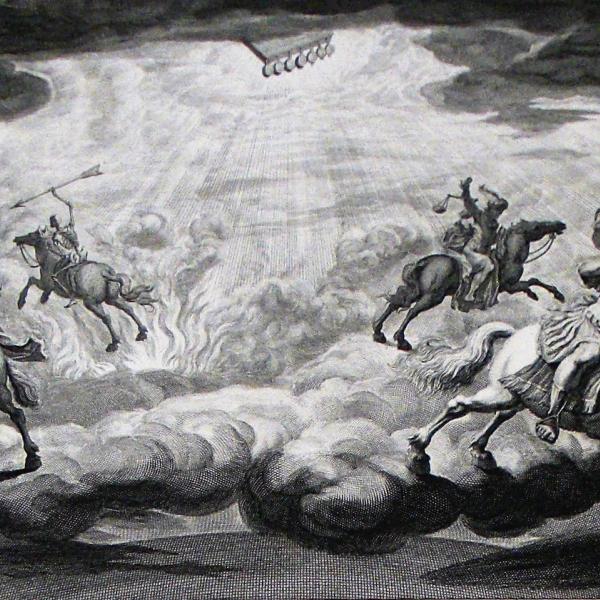In the 1880s, a new kind of performance became the craze in Argentina and Uruguay. These wild "Creole dramas" glorified country life and the occasionally violent exploits of gauchos*, or Argentinian cowboys. In addition to being hugely fun to watch, the stories appealed to audiences experiencing rapid modernization and waves of immigration. William Acree, associate professor of Spanish, helps us envision these plays and understand their lasting significance.
*In the audio, Claire refers to gauchos as "South American cowboys." Please note that the word "gaucho" is associated with cattle workers from certain parts of South America, including Argentina, and not the entire continent.
Transcript:
Claire Navarro (host): Thanks for listening to Hold That Thought. I’m Claire Navarro. Last week on the podcast we got a peek into the world of early 20th century tent shows in the southern United States. This week we also start with performances in tents, but earlier in history and much further south. With the help of William Acree, associate professor of Spanish here at Washington University in St. Louis, we’re heading to the circus. The place: Argentina. The time: Toward the end of the 19th century.
William Acree (guest): So for 15 years more or less – the mid-1880s through the early 1900s - the Creole circus was one of the main entertainment options that people went to see. Groups took it from town to town across Argentina, across Uruguay, sometimes southern Brazil, and it was it was where you had to be if you wanted to see and be seen.
CN: These circuses had a lot of the kinds of acts you might expect – acrobatics, animals, that sort of thing. But in the 1880s, one circus family started something new. They created a type of play called Creole drama. In this part of the world, the word Creole has meant different things at different points in time. But in the 1880s Creole referred to so-called “native sons,” people who were originally from the area. So these Creole dramas had what you might call local flair.
WA: These were wild events. The earliest versions of Creole dramas were done in circus tents or out in the open. And so oftentimes you had several animals that were participants.
CN: We’re not talking about a faithful dog here, or any other small animal.
WA: There would be horse races that would be part of the show. Shearing sheep was something that people could see.
CN: On top of that, bonfires were built on stage and real meat roasted during the shows. All of these effects brought to life the South American countryside, and a very particular kind of story.
WA. The gist of the Creole drama is a story of a good gaucho gone bad.
CN: The gaucho is one kind of South American cowboy. And in the Creole drama, he is the star. Over some 15 years, some 15 of these plays became huge hits. Though there were differences between the plays, they all had a similar story line.
WA: So you have sort of a noble guy who works in the countryside. He has his plot of land and his livestock, he cares for his family, and he has run-ins with the authorities - the police, justices of the peace - for reasons that are usually related to corrupt government. And then begins the downfall of this hero.
CN: Usually the story ends with the death and symbolic resurrection of the gaucho. Of course he doesn’t go down without a fight.
WA: There's a lot of action that's involved, especially in the early ones. Lots of fight scenes with knives. So it had people on the edges of their seats, although most of them were standing.
CN: It’s hard to overstate how popular these plays were. People would go see the shows multiple times. The stories became so well known that they spread beyond the stage and became the pop culture of the time. You could see evidence all over the place.
WA: Some examples: cigarettes took the name of the hero from this play. So people could purchase the cigarette, and in the cigarette box you would have these collectors cards. There was a series of 20 cards, for example, that had images of scenes from the play with a one-sentence description of the scene. So if you collected all 20, you'd have the entire play right there.
CN: So why did these Creole dramas become such a craze? Acree believes there are a few main reasons. For one, these shows were easy to go see and fun to watch.
WA: It was affordable. It was local in terms of the content, as opposed to opera that was performed primarily by European companies with stories that were not about local life. And it gave people a chance to go out with families. This was, believe it or not, a family atmosphere where kids would go, or where husbands and wives would go. Occasionally there were versions of Creole dramas for kids with children performers.
CN: So they were just solid, family-friendly entertainment. But Acree believes that’s not the whole story. During the same period that Creole dramas took off, the lives of many Argentinians were changing rapidly. Land that was once devoted to animals was now being used for cereal crops, and that meant jobs were changing or disappearing. People from the country were moving into cities. And in the cities, they were face to face with newcomers. Immigrants.
WA: So from the 1870s through 1914 this region of southern South America, specifically Argentina and Uruguay, received more immigrants in terms of the size of population than did the United States. It was a pretty radical demographic transformation. And obviously there were tensions that accompanied the arrival of this number of people from abroad, primarily Italy and Spain.
CN: In the face of new people and changing culture, people were drawn to stories that glorified the countryside and its way of life. Acree says you can really see these nativist themes when you look at the immigrant characters in these plays. Especially in the earlier ones, some of the portrayals are pretty harsh – there’s the immigrant thief, or the tricky immigrant. Other depictions are more playful.
WA: There was a character in these plays whose name was Cocoliche. He was an immigrant figure whose purpose was to make people laugh, for the most part. And he made them laugh by using his garbled Spanish. That was his blend of Italian and Spanish, and he would tell jokes, and people could get enough of what he was saying to understand the content. But the way he would frame it with the mix of languages was hilarious.
CN: So you’d think this would set up some pretty intense tension between immigrants and native South Americans, right? Imagine if your accent or culture was getting made fun of all over pop culture, how would you react? So what happened? Did the immigrants boycott the shows? Cause a fuss? Not exactly.
WA: Ironically, immigrant families were the lead Creole drama performers. And immigrants were among the most enthusiastic spectators of these shows.
CN: The immigrant performers can at least partially be explained just by economics. Actors wanted to make money; these plays sold tickets; the show goes on. But what about the immigrants in the audience? Why would anyone want to pay to see themselves stereotyped or mocked?
WA: One of the reasons, and this isn't my original interpretation here, has to do with the way immigrants attempted to assimilate. So being Creole or attending these shows and adopting behaviors, or dress, or forms of speech that they picked up on when they went to see these plays, enabled them to fit in a bit more in this society that was saying, 'Wait a minute, what is it that we really want to look like as Argentines or as Uruguayans here?’
CN: Many of these immigrants didn’t go half way in fandom. They took their love of Creole culture with them everywhere, including to the yearly celebration of Carnivale, which involves dressing up in costume.
WA: There are lots of accounts of immigrants dressing up as these Creole drama heroes at Carnivale, participating in competitions to evaluate who had the most Creole costume that year.
CN: Immigrants also joined social clubs called Creole societies that would celebrate gaucho culture by hosting big barbeques and parades. Versions of these clubs still exist today. And what’s amazing is, as the years passed and immigrants embraced Creole dramas, in some ways, Creole dramas started to embrace them back. Later plays were less harsh in how they portrayed outsiders.
WA: In some instances there are immigrants who are essentially the heroes. After the local native son is killed at the end of the play, it's the immigrant that avenges the death of the local hero. And that says a lot. Even though throughout the play maybe some other gaucho characters have sort of poked fun at this at this immigrant character – his way of speaking, for example.
CN: So, overall, these seemingly simple stories of good gauchos gone bad had a lot going on.
WA: So it was a place that combined the entertainment opportunity with a moment to connect with these experiences that had something to do with changes in society at the end of the 19th century. And I think that really attracted people.
CN: Eventually, the popularity of the Creole drama moved it beyond the world of the traveling circus. With the lure of more money and different audiences, these country shows took their act into the city and even into the opera house. The experience there was a bit different than in earlier performances.
WA: What happened when they moved from the dusty circus tent to the opera house? The bonfire part was cut out, so no more fires on stage. But they did try to make a type of pit where there could be horses that would gallop for, you know, a few meters across the stage in the hope of recreating some of the spirit.
CN: At first, even the toned-down version of Creole drama was not well received by the opera-goers of the time.
WA: At the outset they condemn these plays as one of the most pernicious forms of entertainment, of cultural production that a society could have.
CN: That’s harsh. But once again, the Creole drama won out. Over time, even the urban elite couldn’t resist the story of the good gaucho gone bad.
WA: There are commentaries in newspapers about doctors and politicians attending these plays, and several cases where the presidents of both Argentina and Uruguay are in the audience for a Creole drama. Elements of the plays, like certain types of dance, would be taken up by these new wealthier theater-goers. They would contract dance teachers to learn the moves of these folk dances. And so that's a really interesting thing to get a sense of impact, too. When you see audience makeup change, and when you see sort of the elements of these plays making their way to other areas of life.
CN: So after already bringing of different national origins together, these stories went on to bring people of different classes together. For a piece of pop culture, it’s pretty amazing to think about the reach of these stories.
WA: The plays no doubt brought people together. When people rub shoulders with people who are very different from them - especially when audience makeup started to change and you had wealthy opera-goers who would attend these plays, and there would be the other folks who were the enthusiasts from earlier years - then that's a new dynamic at play.
CN: But, all good things come to an end. After about 20 years, the popularity of the Creole drama started to fizzle out. But, Acree believes that the legacy of these shows is still very present in Argentina and Uruguay today.
WA: I think they really provided the opportunities for a theater-going culture to be born. And that's something that has endured to this day. Anybody who visits Buenos Aires in Argentina or Montevideo in Uruguay, smaller towns too, will pick up on this very vibrant theater scene. Theater is still one of the main entertainment options on weekends, and frankly throughout the week. So when people have the option to go to a movie, or to stay home, or go to a concert, many of them still elect to go to the theater. It's a cool thing to do, to go to the theater.
CN: And there are plenty of options to keep up with demand. The number of theaters in the region is incredible, Acree says, with Buenos Aires being right up there with London and Paris and New York.
WA: My argument is that much of that can be traced back to this theater-going culture that was really created at the turn of the 20th century.
CN: By creating a theater-going culture, Acree argues that these Creole dramas really affected culture more broadly. That’s the thing about theater. Whether it’s performed outside a tent or in an opera house, it’s always about more than what happens on stage.
WA: What happens when people go out, or what happens when they socialize on a regular basis? I think there are bonds that are forged there - conversations that are had about identity, or about current events, and so on, that that are important. For the public health of a society. And so I think that's something that's lasting, too, that these entertainers did. They had no idea that they were doing it, nor did they plan to, or imagine that as a possibility.
CN: A huge thank you to William Acree for joining Hold that Thought. Please visit our website, holthatthoght.wustl.edu, for many more ideas to explore, including more episodes from our recent series “On Stage.” You can also find us on Facebook or Twitter. Thanks for listening.





